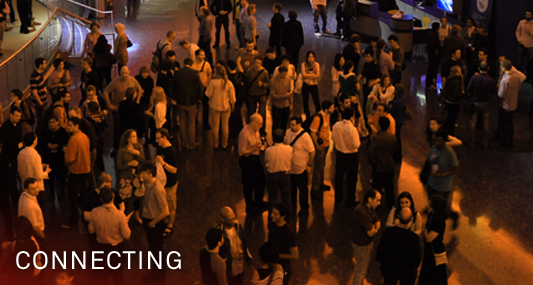
Video Showcase
The videos track is a forum for human-computer interaction that leaps off the page: vision videos, reflective pieces, humor, novel interfaces, studies and other moving images relevant to HCI. This year's selections will have their premiere screenings on Tuesday evening with popcorn and drinks, culminating in the Golden Mouse award ceremony.
Michael S. Bernstein, MIT CSAILShahram Izadi, Microsoft Research
Location: Ballroom A/B
Shows: 17:20-19:00
CHI 2011 Videos
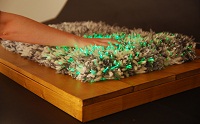 |
PeR: designing for perceptive qualities In this video we show PeR, short for ‘Perception Rug’. The design is created as part of our research on how to design for perceptive qualities in objects. This research is conducted around the educational and research theme ‘Wearable Senses’ and has a theoretical departure in the ‘phenomenology of perception’ and ‘ecological psychology’. The integration of conductive and optic fibers, respectively enable PeR to sense the touch of a person and to let a body of light behave within the surface of the rug. The design can be used as a platform for the exploration of perceptive behavior. Different design characteristics, like the size of the light body, the speed by which the body moves, its shape, focus and direction, can be adjusted in order to design behavior. Eva Deckers, Stephan Wensveen, Kees Overbeeke, Eindhoven University of Technology, Department of Industrial Design, Netherlands |
|
Microwave Racing This video engages a broad audience through the theme of Microwave Racing’ - a title aimed to intrigue. The film is a fun take on a usability testing scenario where four users/riders have to use a microwave for a simple task, and they race against each other. However, there is a serious point which challenges the audience: if we struggle to design for simple everyday things then what about more serious things like medical devices. We think this could challenge a CHI audience and might sit nicely between videos on the latest entertainment and interaction techniques - for juxtaposition. It is a reminder that there is important work to be done in the healthcare domain and that safety-critical HCI can save lives. Dominic Furniss, University College London, UK |
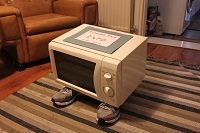 |
 |
Why Buttons Go Bad This video explains in 100 seconds the importance of studying how humans interact with technology. The idea revolves around the evolution of the button and proposes that the design of modern buttons can go wrong when user-centered design is neglected. This was a winning video developed by five MSc students at the UCL Interaction Centre (UCLIC). It was produced as part of a public engagement challenge: to make a digital story that explains what HCI is to young adults. The roles within the video are intentionally caricatured to simplify its message. The video has been used to promote HCI to a wider audience and mark World Usability Day 2010. Philipp Hund, Lucy Hughes, alistair wood, Jesper Garde, Tianbo Xu, University College London, UK |
|
SandCanvas: New Possibilities in Sand Animation Sand animation is a performance art technique in which an artist tells stories by creating animated images with sand. Inspired by this medium, we have developed a new multi-touch digital artistic medium named SandCanvas that simplifies the creation of sand animations.The elegance of sand animation lies in the seamless flow of expressive hand gestures that cause images to fluidly evolve, surprising and delighting audiences. While physical sand animation already possesses these properties, SandCanvas enhances them. SandCanvas’s color and texture features enable faster, more dramatic transitions, while its mixed media and gesture recording features make it possible to create entirely new experiences. Session recording and frame capture complement these capabilities by simplifying post-production of sand animation performances. Rubaiat Habib Kazi, Kien Chuan Chua, Shengdong Zhao, National University of Singapore, Singapore Richard Davis, Singapore Management University, Singapore Kok-Lim LOW, National University of Singapore, Singapore |
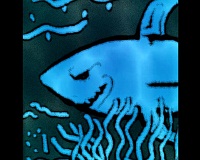 |
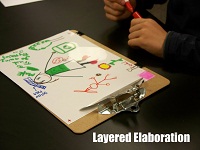 |
Layered Elaboration In this video we describe Layered Elaboration techniques and their use in the cooperative inquiry method. Greg Walsh, Allison Druin, Mona Leigh Guha, Elizabeth Foss, Evan Golub, Leshell Hatley, Elizabeth Bonsignore, Sonia Franckel, University of Maryland, USA |
|
Cube-U: Exploring The Combination Of The Internet Of Things And ELearning Cube-U is an initial prototype that explores the combination of the Internet of Things (IOT) and eLearning. Following a user-centered design process, the powerful possibilities opened by the Internet of Things (IOT) are being included to eLearning in order toenhance the learning experience. IOT is a new field based on the connection of common objects to the internet. So far, it has mainly been applied in industrial environments. Introducing IOT in eLearning will allow for the expansion of the virtual learning experience,currently mostly centered around a computer and paper. Muriel Garreta-Domingo, Open University of Catalonia, Spain |
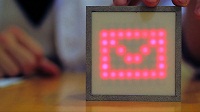 |
 |
Reactive Wall (RWal) This video features a scaled prototype of RWal (Reactive Wall) that was built based upon the floor plan of Hilton San Francisco Union Sq. Continental Ballroom. The RWal is a continuum surface intelligent system that is commissioned in a conference area. It can sense occupancy in different session areas and change its shape dynamically so that it provides more space for a session that is crowded at the expense of reducing the room space for a session that is sparsely populated. Temperature sensors are used to monitor occupancy and the walls are manipulated by tendons driven by servo motors and controlled by an Arduino ATMega328 microcontroller. The wall is actuated (actively and passively) at different points and is designed in such a way that it encloses a constant volume space. The key idea is to manage the available floor area to prevent congestion. This will be a practical option in any conference where there are typically boring as well as interesting speakers and an unavoidable movement of attendees from one session to another. Nivedhitha Giri, Anthony Threatt, Ian Walker, Keith Green, Clemson University, USA |
|
EasyPointer: What You Pointing at is What You Get This video presents a natural pointing system using gyroscope MEMS, which could achieve what you pointing at is what you get. It enables screen interaction via physical pointing. The system only needs a phone with built-in gyroscope, camera, and wireless communication, e.g. Wi-Fi and Bluetooth, without any other hardware. To achieve sensing of the screen position where user is physically pointing, we also develop easy calibration methods. The prototype system, called EasyPointer, is built upon iPhone 4/iPod 4. It can serve as a laser pointer, a presentation controller, a game controller, and a drawing pen. Gang Pan, Haoyi Ren, Weidong Hua, Qian Zheng, Shijian Li, Zhejiang University, China |
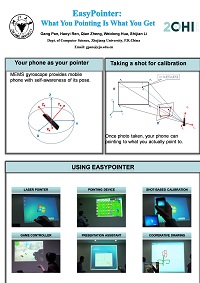 |
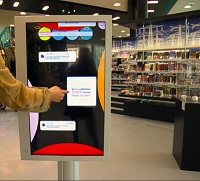 |
BiebBeep: An interactive screen for supporting public Library 2.0 information and social services This video presents BiebBeep, an interactivetouchscreen system that has been developed with theaim to support information and social services for theNew Library in Almere, The Netherlands. The constantlyupdated information displayed on the interactive screenconcerns not only the library itself, but also featureshappenings in the local area. The system’s distinctivefeature is that people can add information to the screenthemselves, such as tweets, photos, local and culturalnews announcements, so that the library and itsvisitors can inform and connect with each other. Overthe course of almost one year, several studies wereconducted, including focus group, interviewandobservation- based studies that have motivated thefunctionality, and particularly the user-generated andlocalized content the system supports. Consequently,the services and functionality the system offers areaimed towards supporting Library 2.0, the nextgeneration library. Marije Kanis, Wouter Meys, Mettina Veenstra, Amsterdam University of Applied Sciences (HvA), Netherlands Maarten Groen, Amsterdam University of Applied Sciences, (HvA) / Novay, Netherlands Wout Slakhorst, Novay, Netherlands |
|
LifeFlow: Visualizing an Overview of Event Sequences (Video Preview) Event sequence analysis is an important task in many domains: medical researchers may study the patterns of transfers within the hospital for quality control; transportation experts may study accident response logs to identify best practices. In many cases they deal with thousands of records. While previous research has focused on searching and browsing, overview tasks are often overlooked. We introduce a novel interactive visual overview of event sequences called LifeFlow. LifeFlow is scalable, can summarize all possible sequences, and represents the temporal spacing of the events within sequences. In this video, we show an example of patient transfer data and briefly demonstrate how to analyze them with LifeFlow. Please see [11] or visit http://www.cs.umd.edu/hcil/lifeflow for more detail. Krist Wongsuphasawat, John Alexis Guerra Gómez, Catherine Plaisant, Taowei Wang, University of Maryland, USA Meirav Taieb-Maimon, Ben-Gurion University of the Negev, Israel Ben Shneiderman, University of Maryland, USA |
 |
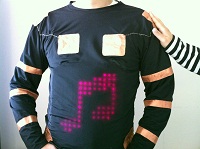 |
Don't Touch: Social Appropriateness of Touch Sensor Placement on Interactive Lumalive E-Textime Shirts In this video, we discuss the design of an e-textile shirt with an interactive Lumalive display featuring a touch- controlled image browser. To determine where to place touch sensors, we investigated which areas of the Lumalive shirt users would be comfortable touching or being touched based on how often participants would opt out of touches. For both touchers and touchees, opt-outs occurred mostly in the upper chest. On the front, the upper chest and lower abdominal zones were the least comfortable. Findings suggest participants were less comfortable with touches on the upper chest, the lower abdomen, and the lower back. We conclude that the most appropriate areas for touch sensors on a shirt are on the arms, shoulders, and upper back. Sylvia Cheng, Connor Dickie, Andreas Hanewich-Hollatz, Justin Lee, Roel Vertegaal, Queen’s University, Canada |
|
Six-Forty by Four-Eighty: An Interactive Lighting Installation Six-Forty by Four-Eighty is an interactive lighting installation composed of an array of magnetic, physical pixels. Individually, pixel-tiles change their color in response to touch and communicate their state to each other by using a person’s body as the conduit for information. When grouped together, the pixeltiles create patterns and animations that can serve as a tool for customizing our physical spaces. Jamie Zigelbaum, Zigelbaum + Coelho, USA Marcelo Coelho, MIT, USA |
 |
 |
Accessible Voting: One Machine, One Vote for Everyone The video for Accessible Voting shows a novel technology that allows private and secure voting to people with disabilities who have previously not had the same access to voting equipment as the common voter. Since the inception of elections and election technologies, all segments of the voting population have never been granted equal access, privacy and security when voting. Voting technology today has not addressed the issues that disabled voters are confronted with at the polls. Because approximately 17% of the voting population is disabled, their issues should be handled with a solution geared towards their needs. Disabled voters need to be able to cast their vote without the assistance of others. The Prime III multimodal voting system addresses these issues. The video illustrates the use of the Prime III system and how it allows disabled voters to use the same system as those without disabilities. Juan Gilbert, Joshua Ekandem, Shelby Darnell, Hanan Alnizami, Aqueasha Martin, Wanda Johnson, Clemson University, USA |
|
Scenario-Based Persona: Introducing Personas Through Their Main Contexts The present work introduces a new way of conveying the results of a user analysis study. Personas are a well established user-centered design methodology; however they are not always wellunderstood or used by non-experts. By explaining our personas based on their main contexts we wanted to 1) reduce the bias that a face can generate by representing silhouettes instead; 2) combine the concepts of personas and scenarios; 3) foster understanding of our users by showing their main contexts (which are becoming more important with the increase of mobile devices); and 4) create a playful and more permanent artefact to hold all this information. Alicia Valls-Saez, Muriel Garreta-Domingo, Open University of Catalonia, Spain |
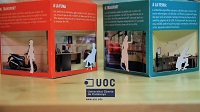 |
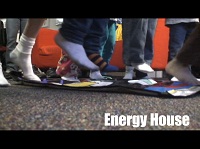 |
Energy House In this video we describe Energy House. Energy House is a game designed with the Cooperative Inquiry Method through the Layered Elaboration technique. Children power items in a virtual house by jumping up and down. Greg Walsh, Allison Druin, Elizabeth Foss, Evan Golub, Mona Leigh Guha, Leshell Hatley, Elizabeth Bonsignore, University of Maryland, USA |
|
Interactive Snow Sculpture Painting This video shows the live-painting of snow sculptures with dabs of digital paint, deploying a mobile phone (virtual spray can) with accelerometer, a PC and a video projector - creating 100% recyclable art. The technology used is called MobiSpray, which has been reported by the author at SIGGRAPH 2009 in the Art papers track. Using a mobile phone in this context allows the painter to roam freely (walk, stand, lie) around the target object, far or near in real physical space, while looking directly at its surface to see how the painting appears in real time. The phone’s keyboard keys are used for controlling the drawing tools such as spraying colors or spraying intensity. Jürgen Scheible, Aalto University, Finland |
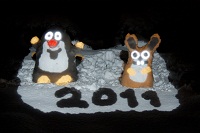 |
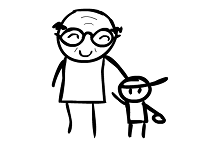 |
SAMM: Driving Asistance System for the Senior Citizen Within a frame of possible ubiquitous urban applications this research explores ways to support the mobility of senior citizens in vehicles by finding efficient routes to reach their destination and managing their time. Our solution is called SAMM and operates following a context-aware and crowdsourcing model where data used by the system to optimize routes is both, taken from user’s agenda and received from other users in real time. This allows older adults to optimize their trips by doing several things without leaving a main route, and to be aware of traffic jams long before other media report it. It is expected that a ubiquitous urban application like SAMM will be of great benefit for elderly people by increasing trip efficiency and avoiding the problems associated with spending excessive time sitting in a vehicle as well as encouraging them to take an active and independent role in society. Víctor González, Roberto Lapuente Romo, Luis Eduardo Pérez Estrada, ITAM, Mexico |
Image credits: Flickr user Too Tall Paul
© 2010 ACM SIGCHI
Contact Webmaster
